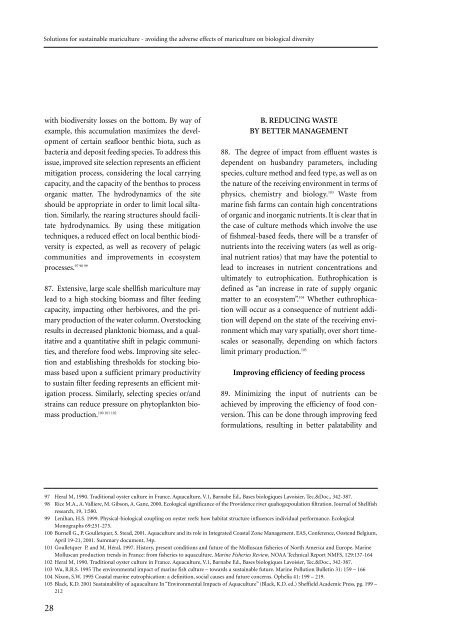Solutions for sustainable mariculture - Convention on Biological ...
Solutions for sustainable mariculture - Convention on Biological ...
Solutions for sustainable mariculture - Convention on Biological ...
- No tags were found...
Create successful ePaper yourself
Turn your PDF publications into a flip-book with our unique Google optimized e-Paper software.
<str<strong>on</strong>g>Soluti<strong>on</strong>s</str<strong>on</strong>g> <str<strong>on</strong>g>for</str<strong>on</strong>g> <str<strong>on</strong>g>sustainable</str<strong>on</strong>g> <str<strong>on</strong>g>mariculture</str<strong>on</strong>g> - avoiding the adverse effects of <str<strong>on</strong>g>mariculture</str<strong>on</strong>g> <strong>on</strong> biological diversitywith biodiversity losses <strong>on</strong> the bottom. By way ofexample, this accumulati<strong>on</strong> maximizes the developmentof certain seafloor benthic biota, such asbacteria and deposit feeding species. To address thisissue, improved site selecti<strong>on</strong> represents an efficientmitigati<strong>on</strong> process, c<strong>on</strong>sidering the local carryingcapacity, and the capacity of the benthos to processorganic matter. The hydrodynamics of the siteshould be appropriate in order to limit local siltati<strong>on</strong>.Similarly, the rearing structures should facilitatehydrodynamics. By using these mitigati<strong>on</strong>techniques, a reduced effect <strong>on</strong> local benthic biodiversityis expected, as well as recovery of pelagiccommunities and improvements in ecosystem97 98 99processes.B.87. Extensive, large scale shellfish <str<strong>on</strong>g>mariculture</str<strong>on</strong>g> maylead to a high stocking biomass and filter feedingcapacity, impacting other herbivores, and the primaryproducti<strong>on</strong> of the water column. Overstockingresults in decreased plankt<strong>on</strong>ic biomass, and a qualitativeand a quantitative shift in pelagic communities,and there<str<strong>on</strong>g>for</str<strong>on</strong>g>e food webs. Improving site selecti<strong>on</strong>and establishing thresholds <str<strong>on</strong>g>for</str<strong>on</strong>g> stocking biomassbased up<strong>on</strong> a sufficient primary productivityto sustain filter feeding represents an efficient mitigati<strong>on</strong>process. Similarly, selecting species or/andstrains can reduce pressure <strong>on</strong> phytoplankt<strong>on</strong> biomass100 101 102producti<strong>on</strong>.REDUCING WASTEBY BETTER MANAGEMENT88. The degree of impact from effluent wastes isdependent <strong>on</strong> husbandry parameters, includingspecies, culture method and feed type, as well as <strong>on</strong>the nature of the receiving envir<strong>on</strong>ment in terms ofphysics, chemistry and biology. 103 Waste frommarine fish farms can c<strong>on</strong>tain high c<strong>on</strong>centrati<strong>on</strong>sof organic and inorganic nutrients. It is clear that inthe case of culture methods which involve the useof fishmeal-based feeds, there will be a transfer ofnutrients into the receiving waters (as well as originalnutrient ratios) that may have the potential tolead to increases in nutrient c<strong>on</strong>centrati<strong>on</strong>s andultimately to eutrophicati<strong>on</strong>. Euthrophicati<strong>on</strong> isdefined as “an increase in rate of supply organicmatter to an ecosystem”. 104 Whether euthrophicati<strong>on</strong>will occur as a c<strong>on</strong>sequence of nutrient additi<strong>on</strong>will depend <strong>on</strong> the state of the receiving envir<strong>on</strong>mentwhich may vary spatially, over short timescalesor seas<strong>on</strong>ally, depending <strong>on</strong> which factorslimit primary producti<strong>on</strong>. 105Improving efficiency of feeding process89. Minimizing the input of nutrients can beachieved by improving the efficiency of food c<strong>on</strong>versi<strong>on</strong>.This can be d<strong>on</strong>e through improving feed<str<strong>on</strong>g>for</str<strong>on</strong>g>mulati<strong>on</strong>s, resulting in better palatability and97 Heral M, 1990. Traditi<strong>on</strong>al oyster culture in France. Aquaculture, V.1, Barnabe Ed., Bases biologiques Lavoisier, Tec.&Doc., 342-387.98 Rice M.A., A. Valliere, M. Gibs<strong>on</strong>, A. Ganz, 2000. Ecological significance of the Providence river quahogs:poulati<strong>on</strong> filtrati<strong>on</strong>. Journal of Shellfishresearch, 19, 1:580.99 Lenihan, H.S. 1999. Physical-biological coupling <strong>on</strong> oyster reefs: how habitat structure influences individual per<str<strong>on</strong>g>for</str<strong>on</strong>g>mance. EcologicalM<strong>on</strong>ographs 69:251-275.100 Burnell G., P. Goulletquer, S. Stead, 2001. Aquaculture and its role in Integrated Coastal Z<strong>on</strong>e Management. EAS, C<strong>on</strong>ference, Oostend Belgium,April 19-21, 2001. Summary document, 34p.101 Goulletquer P. and M. Héral, 1997. History, present c<strong>on</strong>diti<strong>on</strong>s and future of the Molluscan fisheries of North America and Europe. MarineMolluscan producti<strong>on</strong> trends in France: from fisheries to aquaculture. Marine Fisheries Review, NOAA Technical Report NMFS, 129:137-164102 Heral M, 1990. Traditi<strong>on</strong>al oyster culture in France. Aquaculture, V.1, Barnabe Ed., Bases biologiques Lavoisier, Tec.&Doc., 342-387.103 Wu, R.R.S. 1995 The envir<strong>on</strong>mental impact of marine fish culture – towards a <str<strong>on</strong>g>sustainable</str<strong>on</strong>g> future. Marine Polluti<strong>on</strong> Bulletin 31: 159 – 166104 Nix<strong>on</strong>, S.W. 1995 Coastal marine eutrophicati<strong>on</strong>: a definiti<strong>on</strong>, social causes and future c<strong>on</strong>cerns. Ophelia 41: 199 – 219.105 Black, K.D. 2001 Sustainability of aquaculture In “Envir<strong>on</strong>mental Impacts of Aquaculture” (Black, K.D. ed.) Sheffield Academic Press, pg. 199 –21228
















